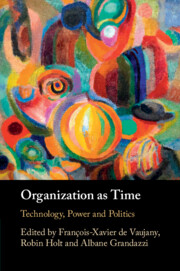Book contents
- Organization as Time
- Organization as Time
- Copyright page
- Contents
- Figures
- Tables
- Contributors
- Organization as Time
- Part I The Politics of Time: Ontologies and Metaphysics of Organization as Time
- Part II Re-orienting Critique in Organization Studies? Exploring Jointly Time and Politics
- Part III New Ways of Organizing Work, Digitality and the Politics of Time
- Part IV History and Duration: Making Things Last, Enduring Politics and Organizing
- 14 Times Alla Turca E Franga
- 15 Temporality and Institutional Maintenance
- 16 A Time for Justice?
- 17 Organizational Memory as Technology
- Conclusion: Time and Political Organizing
- Index
- References
14 - Times Alla Turca E Franga
Conceptions of Time and the Materiality of the Late-Ottoman Clock Towers
from Part IV - History and Duration: Making Things Last, Enduring Politics and Organizing
Published online by Cambridge University Press: 22 June 2023
- Organization as Time
- Organization as Time
- Copyright page
- Contents
- Figures
- Tables
- Contributors
- Organization as Time
- Part I The Politics of Time: Ontologies and Metaphysics of Organization as Time
- Part II Re-orienting Critique in Organization Studies? Exploring Jointly Time and Politics
- Part III New Ways of Organizing Work, Digitality and the Politics of Time
- Part IV History and Duration: Making Things Last, Enduring Politics and Organizing
- 14 Times Alla Turca E Franga
- 15 Temporality and Institutional Maintenance
- 16 A Time for Justice?
- 17 Organizational Memory as Technology
- Conclusion: Time and Political Organizing
- Index
- References
Summary
The study explores the materiality of clock towers to understand how temporal order was constructed and changed in the late Ottoman Empire. It takes a microhistorical perspective with a critical realist lens. Specifically, it focuses on the 24 clock towers constructed between 1876 and 1909 outside Istanbul, remaining within the national borders of Turkey. In addition, the study has developed case studies of three “exceptional typical” clock towers at Kastamonu, Çorum, and Izmir. Results indicate that these clock towers were symbols of continuous and hybridized changes in the temporal construction of Ottoman societies. The study illustrates how alternative time conceptions can exist, combine, and transform autonomously, constituting a polychronous context. In addition to the Ottoman state, the local elite was central in negotiating and contesting the diffusion of modernity into their realms. The study contributes to understanding the politics of time from a non-industrialized and non-Western historical context.
- Type
- Chapter
- Information
- Organization as TimeTechnology, Power and Politics, pp. 297 - 328Publisher: Cambridge University PressPrint publication year: 2023

